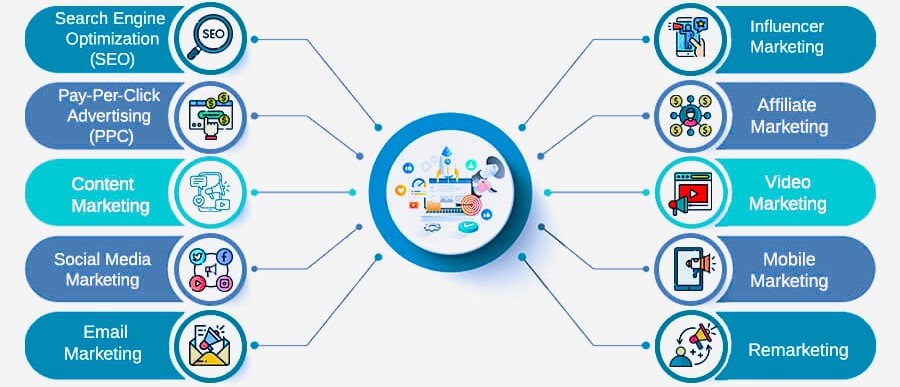In the dynamic landscape of e-commerce, where traditional retail models have often dictated the flow, a revolutionary concept has emerged, transforming how entrepreneurs navigate the market – Drop Shipping. Picture this: a business model that defies conventional norms, enabling individuals to venture into entrepreneurship with minimal risk and overhead costs.
Definition and Basics of Drop Shipping
In its essence, drop shipping is a business strategy that flips the script on traditional retail. Here’s the gist: instead of stocking up on inventory and managing the complexities of warehousing, drop shippers act as intermediaries, connecting customers with products without ever handling the goods themselves. This innovative solution ensures that entrepreneurs can dive into the world of commerce without the burdensome weight of upfront costs and inventory management. Now, let’s delve into how this unconventional method differs significantly from the age-old retail models.
A brief explanation of drop shipping:
Drop shipping is not just a business model; it’s a paradigm shift. It’s about entrepreneurs collaborating with suppliers to fulfill customer orders seamlessly, all without the need to stock or handle the products themselves.
How it differs from traditional retail models:
Unlike traditional retail, where maintaining physical inventory is paramount, drop shipping liberates entrepreneurs from the constraints of warehousing and inventory. This means no upfront costs, storage woes, and an agile approach to customer demands.
The Rise of Drop Shipping in E-commerce
Now, let’s journey back in time, exploring the historical context that laid the groundwork for the rise of drop shipping. As we navigate through the annals of commerce, it becomes evident that drop shipping is not merely a recent phenomenon but a trend woven into the fabric of e-commerce evolution.
Historical context:
Drop shipping, in various forms, has been a part of commerce for decades. However, its widespread adoption gained momentum with the digital revolution, particularly as e-commerce platforms became the epicenter of global trade.
Factors contributing to its popularity:
The surge in digital connectivity and the quest for streamlined business processes propelled drop shipping into the spotlight. Factors like globalization, technological advancements, and the quest for financial freedom have converged to make drop shipping a viable and attractive option for aspiring entrepreneurs.
Benefits and Challenges of Drop Shipping
As we set the stage for mastering drop shipping, let’s not shy away from addressing both sides of the coin. Drop shipping is not without its challenges, yet its advantages can be transformative for those who navigate the nuances of this unique business model.
Advantages for entrepreneurs:
- Low upfront costs and minimal financial risk.
- Flexibility to test and scale a variety of products.
- Focus on marketing and customer engagement rather than logistics.
Common challenges and how to overcome them:
- Inventory management complexities.
- Dependence on third-party suppliers.
- Intense competition in saturated markets.
Getting Started with Drop Shipping

Embarking on your drop shipping journey is akin to navigating uncharted waters, and like any explorer, finding the right compass is crucial. In this section, we’ll unravel the mysteries of getting started, focusing on three pivotal aspects that lay the groundwork for drop shipping success.
Finding Profitable Niches
- Research methods for identifying niches: In the vast expanse of e-commerce possibilities, searching for a profitable niche demands a strategic approach. Imagine it as a treasure hunt; your map comprises comprehensive market research. Dive into trending topics, conduct keyword analysis, and explore untapped consumer needs. Remember, the riches lie where demand intersects with your passion and expertise.
- Criteria for selecting profitable niches: Like a savvy investor, scrutinize potential niches through viability and sustainability. Consider factors such as product demand, competition intensity, and audience engagement. Picture yourself as a curator, handpicking a niche that aligns with market trends and your authentic interests and understanding.
Selecting Reliable Suppliers
In the vast supplier marketplace, choosing the right ally is akin to selecting a trustworthy companion for your journey. Evaluating supplier credibility is paramount –assurance that the treasures you promise your customers are genuine.
- Evaluating supplier credibility: Like forming real-life partnerships, delve into supplier backgrounds. Scrutinize their track record, customer reviews, and reliability. This is your due diligence, ensuring that your chosen suppliers are not just vendors but partners committed to your success.
- Red flags to watch out for: Be vigilant for warning signs in the supplier landscape. Unreliable communication, inconsistent product quality, and delayed shipments are red flags. Picture these red flags as caution signs along your journey – detours that might lead to potential pitfalls.
Setting Up an E-Commerce Store
Your digital storefront is not merely a virtual space; it’s the welcoming entrance to your dropshipping empire. Setting up an e-commerce store involves meticulous planning and design finesse – envision it as crafting a cozy and inviting shop on a bustling street.
- Choosing the right platform: Choosing your e-commerce platform is akin to selecting the foundation for your dream house. Consider factors like user-friendliness, scalability, and integration capabilities. Picture it as finding the perfect location for your shop, ensuring it aligns with your target audience’s preferences.
- Design tips for a user-friendly experience: Imagine your e-commerce store as a well-organized boutique. Implement clean layouts, intuitive navigation, and compelling visuals. Think of it as arranging your merchandise to entice customers to explore further. You aim to create a seamless and enjoyable experience for visitors, converting them from curious browsers to loyal customers.
Navigating Product Sourcing and Inventory Management
In the bustling drop shipping marketplace, success hinges on sourcing products and mastering the delicate dance of inventory management. It’s akin to balancing on a tightrope – a skill that requires precision, foresight, and a touch of creativity.
Effective Product Sourcing Strategies
- Diversifying suppliers: Imagine your drop shipping venture as a garden and your suppliers as its varied plants. Diversification isn’t just a strategy; it’s a safeguard against potential pitfalls. Much like cultivating a diverse ecosystem minimizes the impact of external factors, sourcing products from various suppliers ensures resilience in the face of unforeseen challenges.
- Negotiating favorable terms with suppliers: Negotiation is an art, and in drop shipping, it’s your brushstroke on the canvas of profitability. Picture it as a friendly conversation rather than a battlefield. Seek terms that benefit both parties, creating a symbiotic relationship. Just as a skilled artist brings out the best in their subject, skilled negotiation enhances the mutual benefit between you and your suppliers.
Inventory Management Best Practices
Navigating the seas of inventory management can be treacherous without a reliable compass. Efficient tracking systems are your guiding star, ensuring you stay afloat and sail smoothly toward success.
- Implementing efficient tracking systems: Picture your inventory as a puzzle and a tracking system as the solution to piece it together seamlessly. Implementing efficient systems, whether through advanced software or streamlined manual processes, prevents the puzzle pieces from getting lost. This ensures you’re not left grappling with the chaos of misplaced goods when customers come knocking.
- Dealing with stockouts and overstock situations: Imagine your inventory as a delicate ecosystem. Stockouts are akin to droughts, overstock situations, and floods. Both can be detrimental to your business. Employ forecasting tools to predict demand, ensuring your inventory levels align with customer needs. As a skilled gardener tends to their plants, vigilant inventory management ensures your shelves are neither barren nor overcrowded.
Automating Order Fulfilment
Automation is the wind beneath the sails of successful drop shipping, propelling your business forward with unparalleled efficiency. Consider it the magic wand that transforms manual tasks into seamless processes, freeing up your time for strategic endeavors.
- Overview of order processing automation tools: Picture automation tools as your trusty crew, handling mundane tasks precisely. From order processing to tracking, these tools streamline your operations, leaving you more time to navigate the strategic waters of your business. Imagine the freedom of focusing on growth rather than drowning in operational details.
- Benefits of streamlining fulfillment processes: Streamlining isn’t just about efficiency; it’s about creating a customer experience that rivals a smooth sailing voyage. Customers receive their products promptly when orders are processed seamlessly, enhancing satisfaction and loyalty. Picture it as orchestrating a symphony where each note aligns perfectly, leaving your customers applauding your impeccable performance.
Marketing and Branding for Drop Shipping Success
In the vast ocean of e-commerce, your drop shipping venture is not just a ship; it’s a unique vessel sailing toward success. Navigating these waters requires more than just products – it demands the artistry of branding and the strategic maneuvers of digital marketing. As we set sail into marketing and branding, envision your venture as a business and as a captivating narrative waiting to be written.

Creating a Strong Brand Identity
- Importance of branding in drop shipping: Imagine your brand as the lighthouse guiding customers through the fog of choices. In drop shipping, where options are abundant, a strong brand identity is not just a preference; it’s a necessity. It’s the difference between being lost at sea and finding a trusted harbor. Your brand is your signature in the vast marketplace, offering assurance to customers seeking reliability.
- Tips for building brand recognition: Like a master storyteller, weave tales that resonate and craft your brand story authentically. Ensure consistency across your logo, color palette, and messaging. Think of it as painting a vivid picture of your brand, one that customers can recognize even in the crowded sea of e-commerce.
Digital Marketing Strategies
- Utilizing social media for promotion: Social media is your virtual crew, ready to spread the word about your drop shipping treasure trove. Visualize it as setting sail on different social media platforms, each wave of content reaching potential customers. Engage, share, and create a community around your brand. It’s not just promotion; it’s fostering connections that withstand the storms of competition.
- Implementing effective email marketing campaigns: Email marketing is your message in a bottle, reaching customers directly and personally. Picture it as crafting messages that resonate with your audience, addressing their needs and desires. It’s not just about sending emails; it’s about creating a dialogue and turning casual subscribers into loyal patrons.
SEO Techniques for Drop Shipping Websites

- Optimizing product listings: SEO is your treasure map in the vast realm of the internet. Visualize each product listing as a marked spot strategically placed for discovery. Optimize titles, descriptions, and images, ensuring your offerings are not lost in the digital expanse. It’s about making your products the X that customers eagerly seek.
- Building quality backlinks for improved rankings: Backlinks are the wind in your sails, propelling your website to higher visibility. Picture it as forging alliances with reputable partners in the e-commerce seas. Focus on quality over quantity, building a network of links that affirm your credibility. It’s not just about links; it’s about creating pathways that direct customers to your virtual shores.
Customer Service Excellence in Drop Shipping
As your drop shipping venture sails through the vast expanse of e-commerce, consider customer satisfaction as the anchor that keeps your ship steady amidst turbulent seas. Customer service excellence isn’t just a support function; it’s the heartbeat of your business, resonating with the needs and expectations of your clientele.
Importance of Customer Satisfaction
- Building trust with customers: Trust is the invisible thread that connects your ship to its passengers. Imagine each successful transaction as a sturdy knot, strengthening the bond between you and your customers. Trust isn’t just earned; it’s the currency that fuels repeat business and positive word-of-mouth.
- Impact on long-term success: Customer satisfaction is the wind beneath your sails, propelling your ship towards long-term success. Picture each satisfied customer as a guiding star, leading the way through the competitive seas. In the ever-evolving e-commerce landscape, fostering lasting relationships ensures your ship weathers storms and sails toward new horizons.
Handling Returns and Customer Inquiries
- Establishing clear return policies: Returns can be the storms in the e-commerce seas, but they become manageable waves with clear policies. Imagine a transparent return policy as a nautical chart, guiding customers through the process with clarity and fairness.
- Providing responsive customer support: Customer inquiries are the ripples that can turn into waves if left unattended. Responding promptly is like throwing a lifeline to customers. Picture it as a responsive crew, ensuring that questions are answered, concerns are addressed, and customers feel heard, even amid turbulent seas.
Leveraging Customer Feedback for Improvement
- Collecting and analyzing customer feedback: Customer feedback is your compass, pointing towards areas of improvement and hidden treasures. Envision feedback as a valuable map, guiding you through uncharted territories. Collect and analyze it with the diligence of a seasoned explorer, extracting insights that can shape your ship’s course.
- Implementing changes based on feedback: Implementing changes based on feedback is like adjusting sails to catch the optimal wind. Picture it as a ship captain adapting to changing conditions. Use feedback to fix issues and enhance the overall journey, ensuring your ship becomes more resilient and customer-centric with each voyage.
Scaling Your Drop Shipping Business
As the winds of success fill your drop shipping sails, the time comes to set course for uncharted territories and expand your empire. Scaling your business isn’t just about growth; it’s about orchestrating a symphony of strategies that elevate your venture to new heights.

Strategies for Scaling Up
- Increasing product offerings: Think of your offerings as a vibrant tapestry, each item a thread contributing to the masterpiece. Scaling involves weaving more threads into your tapestry and expanding your catalog to cater to diverse customer needs. Like a seasoned chef adding new dishes to a menu, broaden your offerings to keep customers returning for more.
- Expanding to new markets: Imagine your drop shipping ship as a global explorer, setting sail to uncharted markets. Expansion isn’t just about reaching new shores; it’s about adapting to the customs and tastes of diverse audiences. Visualize it as translating your brand story into different languages, ensuring it resonates with customers worldwide.
Avoiding Common Pitfalls in Scaling
- Managing increased order volume: Scaling can be a double-edged sword, bringing increased orders but also the challenge of managing them efficiently. Think of order management as orchestrating a bustling marketplace. Implement robust systems and processes to ensure that as order volume surges, your ship sails smoothly, fulfilling each order with precision.
- Ensuring consistent quality and customer service: Scaling isn’t just about quantity; it’s about maintaining the quality that sets your venture apart. Imagine customer satisfaction as the compass guiding your ship. Even as you expand, ensure consistent quality and top-notch customer service. Picture it as offering the same warm welcome to every customer, regardless of your business’s size.
Conclusion
As our journey through the seas of drop shipping reaches its harbor, let’s dock our ship and reflect on the treasures unearthed.
Drop shipping, heralded as a modern e-commerce marvel, is the captain navigating the ever-expanding seas of entrepreneurship. Its ingenious model streamlines inventory management and acts as the wind beneath the sails of aspiring business owners. However, success in this dynamic realm hinges on adeptly navigating the challenges that arise, be it the artful selection of niches or the mastery of customer service excellence. As entrepreneurs chart their course, scaling emerges as the next frontier, requiring them to broaden their product offerings, explore new markets, and deftly sidestep common pitfalls. In this ocean of opportunity, each wave presents a chance for growth, learning, and the ultimate triumph of the enterprising spirit.
In the vast ocean of e-commerce, remember: your ship may face storms, but with resilience, strategy, and a customer-centric approach, you’ll sail toward success. The waves may be challenging, but each brings the opportunity to navigate, learn, and triumph. As you set sail on your drop shipping odyssey, embrace the journey, adapt to the winds of change, and chart a course to prosperity. Fair winds and following seas, aspiring drop shippers!


1 comment
Hey there! This is my first comment here so I just wanted to give a quick shout out and
tell you I truly enjoy reading through your posts.
Can you suggest any other blogs/websites/forums that go over the same
topics? Many thanks!